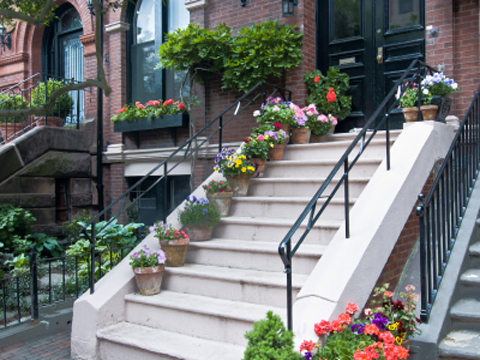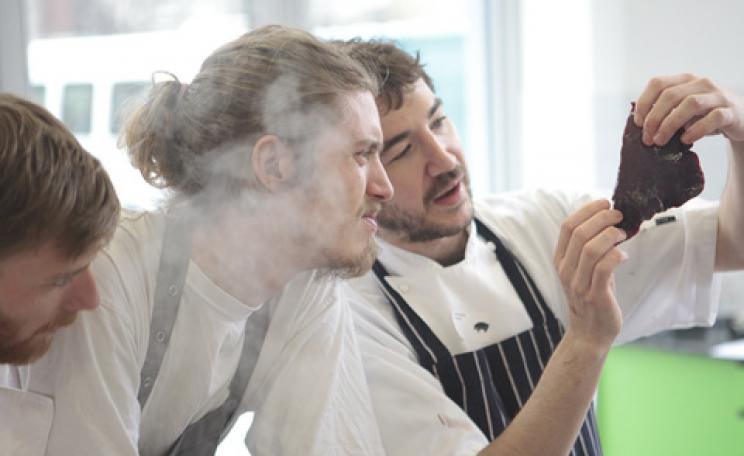Orchards have long been an integral part of the British countryside, conjuring up idyllic summer scenes with bees buzzing and windfalls gently thudding to the ground. But this is a scene that’s under threat. A 2009 study by Natural England and the National Trust estimated England has lost 60 per cent of her small traditional orchards since 1950 putting many local varieties, some of which are unique to a few square miles, in danger. Apples were first cultivated in the UK during the Roman occupation, but today, despite the recent fall in orchard land space, the UK apple trade is worth £115 million a year according to the Institute for Food Research, but only 31 per cent of eating apples sold in this country are grown in the UK.
But orchards aren’t only for apples and pears; they also provide a valuable ecosystem for local flora and fauna. In 2007 they were designated a ‘priority habitat’ under the UK’s Biodiversity Action Plan. ‘Orchards are particularly important for wildlife, the spacing out of trees, the canopy are perfect for butterflies and bees. The spaces make the difference, traditional and organic orchards are especially important because they aren’t treated with chemicals,’ Jon Stokes of the Tree Council told the Ecologist. Keeping our orchards alive is now more important than ever, so if you’re worried about yours and need some help to keep it going, we’ve got the lowdown on what to do.
Planting
The vast variety of apples varieties, tree sizes and root structures mean you can custom design an orchard to fit almost any space. Whether one tree in an urban back garden, or a smallholding in the country, a few simple tips should help you get the best from your bushel. Choosing your variety is a good place to start, if not a simple one. There are over 2,500 varieties of apples in the National Fruit Collection at Brogdale in Kent. ‘It's largely about personal taste,’ says Stokes, ‘do you want eaters or cookers, early middle or late bloomers? My personal favourite is the clay gate pearmain. Bramleys are a good place to start, but it’s worth going to some Apple Fayres in the autumn and having a taste.’
 Once you’ve chosen your variety, the Orchard Network recommends, for those of you planning new orchards, apples trees are planted at intervals of between eight and 10 metres. Cherries need a bit more room but plums can be packed a little tighter. It’s best to plant new trees when they are not in leaf, so between November and March. A sapling may require a stake to help strengthen the roots, and a young tree will also require a guard against grazing animals. It is also recommended to weed a metre-wide circle around new trees for the first couple of years to stop it competing for water resources. John Hancox, from Scottish Fruit Trees, says it’s important to get the preparation right. ‘When you are planting trees make sure these are of varieties which are suitable for the local conditions,’ he advises. ‘In Scotland hardy varieties such as Stirling Castle and Galloway Pippin are needed but specialist advice from a local nursery is well worth getting. You don't want trees too big for the site, and equally you want the tree to be vigorous enough to thrive. It's well worth taking the time to learn to prune correctly.’
Once you’ve chosen your variety, the Orchard Network recommends, for those of you planning new orchards, apples trees are planted at intervals of between eight and 10 metres. Cherries need a bit more room but plums can be packed a little tighter. It’s best to plant new trees when they are not in leaf, so between November and March. A sapling may require a stake to help strengthen the roots, and a young tree will also require a guard against grazing animals. It is also recommended to weed a metre-wide circle around new trees for the first couple of years to stop it competing for water resources. John Hancox, from Scottish Fruit Trees, says it’s important to get the preparation right. ‘When you are planting trees make sure these are of varieties which are suitable for the local conditions,’ he advises. ‘In Scotland hardy varieties such as Stirling Castle and Galloway Pippin are needed but specialist advice from a local nursery is well worth getting. You don't want trees too big for the site, and equally you want the tree to be vigorous enough to thrive. It's well worth taking the time to learn to prune correctly.’
Some well timed, and well placed pruning can help keep the tree healthy, stimulate growth, and encourage new fruit by allowing air and light to reach parts of the tree previously overrun. When cutting off diseased wood – suffering from canker for example - always cut back until you reach healthier material. Cut-offs can be left in a pile in the orchard to provide habitats and increase your orchards biodiversity, but any diseased wood should be removed from the area and brunt to avoid contamination. Courses on pruning are available up and down the country, and information, along with a list of specialist fruit nurseries can be found on the Orchard Network’s website.
Dead branches aside, there are a couple of common ailments to be on the lookout for and the most common of all is brown rot. Brown rot spreads from wounds caused by birds and shows on the surface of the fruit as, unsurprisingly, a brown mouldy looking rot. This doesn’t affect the tree itself but can spread to other fruit. Best advice to remove the infected fruit and compost. Other common fungal diseases effecting orchard trees can often be treated in the same way. Other disfigurating diseases, bitter pit for example, don’t damage the fruit, but simply discolour it and give a slightly bitter taste. Some fruits are hardier than others as are some varieties. It’s recommended to research the type of soil you have and select the best variety from that starting point. According to Hancox, the best advice is to enjoy it, ‘Don't worry too much about getting it exactly right. Planting fruit trees should be fun and is also very satisfying. The best thing is to keep an eye on the trees - make sure that tree ties are not constricting the tree, or that the tree is not rubbing on stakes. They say that the gardeners shadow is the best fertiliser.’
Biodiversity
For those who don’t want to rely on chemicals to keep their trees going, the Permaculture Association suggests planting a variety of other species in your orchard to confuse pests. Allowing dandelions and nettles will also help attract pest predators thus keeping their population in check. You can also develop your orchard into a forest garden by planting complimentary species. Rhubarb, for example, is particularly shade tolerant and crops before the canopy comes into leaf, giving you more fruit for your space. ‘If I could give one piece of advice,’ says Stokes, ‘[it would be] hedge your orchard. Bumblebees live in hedges, so providing them with habitat will encourage them in, and also help pollinate your orchard.’
 Community and urban orchards
Community and urban orchards
Small community orchards have been springing up around the country. Often doubling up as educational facilities for local schools. Natural England provides funding to small scale farming projects under its Environmental Stewardship scheme, and the Department for the Environment Farming and Rural Affairs delivers grants for tree planting, community orchard projects current account for a quarter of the money delivered from this scheme.
Despite small-scale urban orchards being a common sight across Victorian London, these have all but died out. However, the London Orchard Project (LOP) has launched a new initiative aimed at reconnecting Londoners with the fruit they eat, maintaining green spaces and bringing local communities together to share in the process. ‘The London Orchard Project started back in 2009 to address the gap between people’s love of home grown fruit and their ability and confidence to grow it themselves.’ Kath Rosen of the London Orchard Project, told the Ecologist. ‘Getting involved in a local project is a great way to meet your neighbours, learn new skills and cut your food miles. You can also get in touch with your local food heritage, we try and plant trees developed in the local area. South London used to be a massive fruit producing region, and in our projects we’ve been planting Cellini which was developed by breeder around the Vauxhall area.’ You can get involved by visiting LOP’s website, or for projects outside the capital take a look at the Common Ground website.
Small scale orchard planting is a fun and easy way to get yourself out in the fresh air, back in touch with your food, and get some tasty and healthy fruit in the process, all while aiding local biodiversity. Orchards might be a small step but they’re one green initiative that works for everyone.
| READ MORE... | |
 |
GREEN LIVING Ten of the best…ways to get stuck into urban gardening Growing your own fruit and vegetables doesn’t have to involve huge amounts of space. As Hannah Corr explains, there are plenty of short cuts for city dwellers who want to get stuck in |
 |
GREEN LIVING How to handle the hosepipe ban: everything you ever wanted to know Despite the spring downpours, a hosepipe ban is already in force thanks to drought. It’s time to rethink how we use water in the garden, says author Michael Littlewood |
 |
GREEN LIVING Why bees & biodiversity benefit from indigenous wildflowers Filling your garden with wildflowers helps honeybees and butterflies, and creates a relaxed mood. And, from the Easton Walled Garden to Sissinghurst, there's plenty of inspiration |
 |
GREEN LIVING How to… grow and use herbs Expand your culinary horizons, says Michael Littlewood, as a confident hand with home-grown herbs will add a new dimension to your cookery |
 |
GREEN LIVING The beginner’s guide to making your own compost Contrary to popular belief, composting is simple. What’s more, it’s also eco-friendly, cheap and utterly addictive. Hannah Corr shows you how to get started |








